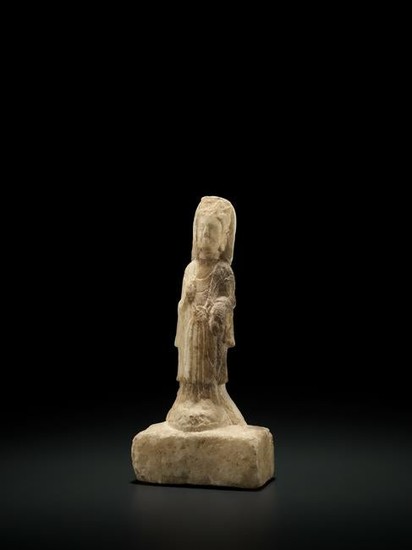A RARE YELLOW MARBLE AVALOKITESHVARA, QI DYNASTY
A RARE YELLOW MARBLE FIGURE OF AVALOKITESHVARA, NORTHERN QI DYNASTY
China, 550-577. Elegantly carved in the form of Avalokiteshvara standing sturdily on a round lotus base supported by a rectangular plinth, the figure portrayed with both elbows bent, adorned in robes cascading in voluminous folds, the serene expression framed by a cowl.
Provenance: From an old Swiss private collection.
Condition: Extensive wear, encrustations and weathering with areas of erosion. Minor losses. Old and visible repair to two vertical fissures. Overall condition exactly as expected from a statue of this age.
Weight: 1021.7 g
Dimensions: Height 22.3 cm
This rare statue displays the major artistic developments of the Northern Qi dynasty, one of the most vibrant periods in the history of Chinese lapidary work, when carvers began incorporating a heightened awareness of the human body in their works. The rounded contours clothed in lightweight robes evidence this first attempt at naturalism and mark an important shift from the strict linearity of the preceding Northern Wei dynasty.
The collapse of the Wei dynasty and resultant split of China into the Northern Qi (550-577) dynasty in the east and the Northern Zhou (557-581) dynasty in the west, had a profound influence on Buddhist doctrine and art in China. While the Gandharan and Mathuran schools of Kushan India had influenced the art of the Northern Wei, Northern Qi carvers turned to the sensuous sculptures of the Gupta School for inspiration. This approach to the human body is best displayed in the sculptures of the Northern and Southern Xiantangshan caves, situated between Henan and Hebei, close to the capital Ye, and in votive statues such as the present. These sculptures feature rounder figures dressed in unobtrusive elegant robes, lacking the heavy straight folds of drapery of the preceding dynasty, and a naturalistic, more benevolent approach to the rendering of facial expressions.
罕見漢白玉觀音立像,北齊
中國,550-577。觀音站立矩形底座上的蓮花座上,手肘彎曲,長褶疊疊的長袍,面容慈祥。
來源:瑞士私人收藏
品相:廣汎磨損,局部結殼、風化侵蝕。 輕微缺失。 兩個垂直裂縫曾進行修復。總體狀況完全符合這個時代雕像。
重量:1021.7 克
尺寸:高22.3 厘米
Sale price
Estimate
Time, Location
Auction House
A RARE YELLOW MARBLE FIGURE OF AVALOKITESHVARA, NORTHERN QI DYNASTY
China, 550-577. Elegantly carved in the form of Avalokiteshvara standing sturdily on a round lotus base supported by a rectangular plinth, the figure portrayed with both elbows bent, adorned in robes cascading in voluminous folds, the serene expression framed by a cowl.
Provenance: From an old Swiss private collection.
Condition: Extensive wear, encrustations and weathering with areas of erosion. Minor losses. Old and visible repair to two vertical fissures. Overall condition exactly as expected from a statue of this age.
Weight: 1021.7 g
Dimensions: Height 22.3 cm
This rare statue displays the major artistic developments of the Northern Qi dynasty, one of the most vibrant periods in the history of Chinese lapidary work, when carvers began incorporating a heightened awareness of the human body in their works. The rounded contours clothed in lightweight robes evidence this first attempt at naturalism and mark an important shift from the strict linearity of the preceding Northern Wei dynasty.
The collapse of the Wei dynasty and resultant split of China into the Northern Qi (550-577) dynasty in the east and the Northern Zhou (557-581) dynasty in the west, had a profound influence on Buddhist doctrine and art in China. While the Gandharan and Mathuran schools of Kushan India had influenced the art of the Northern Wei, Northern Qi carvers turned to the sensuous sculptures of the Gupta School for inspiration. This approach to the human body is best displayed in the sculptures of the Northern and Southern Xiantangshan caves, situated between Henan and Hebei, close to the capital Ye, and in votive statues such as the present. These sculptures feature rounder figures dressed in unobtrusive elegant robes, lacking the heavy straight folds of drapery of the preceding dynasty, and a naturalistic, more benevolent approach to the rendering of facial expressions.
罕見漢白玉觀音立像,北齊
中國,550-577。觀音站立矩形底座上的蓮花座上,手肘彎曲,長褶疊疊的長袍,面容慈祥。
來源:瑞士私人收藏
品相:廣汎磨損,局部結殼、風化侵蝕。 輕微缺失。 兩個垂直裂縫曾進行修復。總體狀況完全符合這個時代雕像。
重量:1021.7 克
尺寸:高22.3 厘米



